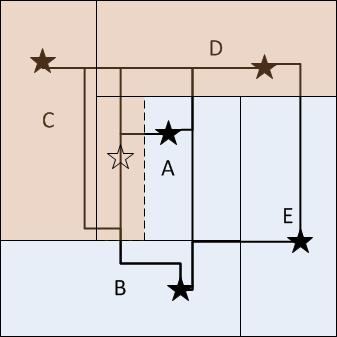Difference between revisions of "Fragment"
(Created page with 'A fragment is a contiguous geographic unit created by a chop of a larger whole geographic unit. A fragment that contains the node of the whole geographic unit has that sa…') |
|||
| Line 1: | Line 1: | ||
A fragment is a contiguous geographic unit created by a [[chop]] of a larger whole geographic unit. A fragment that contains the [[node]] of the whole geographic unit has that same node as the node of the fragment. A fragment that does not contain the node of the whole geographic unit has as its node the node of the largest population [[subunit]] in the fragment. Fragment nodes only serve as reference points and are not used to determine connections. | A fragment is a contiguous geographic unit created by a [[chop]] of a larger whole geographic unit. A fragment that contains the [[node]] of the whole geographic unit has that same node as the node of the fragment. A fragment that does not contain the node of the whole geographic unit has as its node the node of the largest population [[subunit]] in the fragment. Fragment nodes only serve as reference points and are not used to determine connections. | ||
| − | [[Connection | + | [[Connections|Connection]] for fragments follow from the connections that exist in the whole geographic unit. Paths used as connections that enter the whole unit within a fragment are links to the node of that fragment. Two fragments in the same whole unit that are locally connected are connected with a link between their nodes. In general the only links created from a chop are the links between fragments in the same whole unit. |
===Example 1=== | ===Example 1=== | ||
| + | [[File:Connect5B.jpg]] | ||
| + | |||
| + | The shaded area represents a district that chops unit A. | ||
| + | |||
| + | The fragment of A on the right has a node from the original whole unit A. The fragment on the left has a node created at the node largest population subunit - shown as a hollow star. | ||
| + | |||
| + | The right side fragment is connected to D, B and E. | ||
| + | |||
| + | The left side fragment is connected to C. | ||
| + | |||
| + | The two fragments are connected to each other. | ||
| + | |||
| + | The equivalent graph colors the nodes of the two districts in different colors. The dashed links represent secondary paths to the nodes that do not count as connections. The red links indicate connections and secondary paths that link nodes in different districts. | ||
| + | |||
| + | [[File:Connect5B.jpg]] | ||
===Isolated Fragments=== | ===Isolated Fragments=== | ||
Some fragments may have no connections based on the connections of the whole unit. These are isolated fragments. For isolated fragments links are created to each adjacent unit that is locally connected to the fragment node. | Some fragments may have no connections based on the connections of the whole unit. These are isolated fragments. For isolated fragments links are created to each adjacent unit that is locally connected to the fragment node. | ||
Revision as of 21:31, 29 March 2016
A fragment is a contiguous geographic unit created by a chop of a larger whole geographic unit. A fragment that contains the node of the whole geographic unit has that same node as the node of the fragment. A fragment that does not contain the node of the whole geographic unit has as its node the node of the largest population subunit in the fragment. Fragment nodes only serve as reference points and are not used to determine connections.
Connection for fragments follow from the connections that exist in the whole geographic unit. Paths used as connections that enter the whole unit within a fragment are links to the node of that fragment. Two fragments in the same whole unit that are locally connected are connected with a link between their nodes. In general the only links created from a chop are the links between fragments in the same whole unit.
Example 1
The shaded area represents a district that chops unit A.
The fragment of A on the right has a node from the original whole unit A. The fragment on the left has a node created at the node largest population subunit - shown as a hollow star.
The right side fragment is connected to D, B and E.
The left side fragment is connected to C.
The two fragments are connected to each other.
The equivalent graph colors the nodes of the two districts in different colors. The dashed links represent secondary paths to the nodes that do not count as connections. The red links indicate connections and secondary paths that link nodes in different districts.
Isolated Fragments
Some fragments may have no connections based on the connections of the whole unit. These are isolated fragments. For isolated fragments links are created to each adjacent unit that is locally connected to the fragment node.

